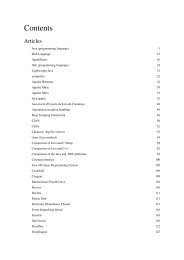Essentials of Javascript - Cultural View
Essentials of Javascript - Cultural View
Essentials of Javascript - Cultural View
Create successful ePaper yourself
Turn your PDF publications into a flip-book with our unique Google optimized e-Paper software.
JSON 104<br />
parseResponse({"Name": "Cheeso", "Rank": 7})<br />
...which can cause a change <strong>of</strong> state within the browser's execution context, because it invokes a method.<br />
The Padding<br />
While the padding (prefix) is typically the name <strong>of</strong> a callback function that is defined within the execution context <strong>of</strong><br />
the browser, it may also be a variable assignment, an if statement, or any other <strong>Javascript</strong> statement prefix.<br />
Script Tag Injection<br />
But to make a JSONP call, you need a script tag. Therefore, for each new JSONP request, the browser must add a<br />
new tag -- in other words, inject the tag -- into the HTML DOM, with the desired value for the src attribute.<br />
This element is then evaluated, the src URL is retrieved, and the response JSON is evaluated.<br />
In that way, the use <strong>of</strong> JSONP can be said to allow browser pages to work around the same origin policy via script<br />
tag injection.<br />
Basic Security concerns<br />
Because JSONP makes use <strong>of</strong> script tags, calls are essentially open to the world. For that reason, JSONP may be<br />
inappropriate for carrying sensitive data. [24]<br />
Including script tags from remote sites allows the remote sites to inject any content into a website. If the remote sites<br />
have vulnerabilities that allow JavaScript injection, the original site can also be affected.<br />
Cross-site request forgery<br />
Naïve deployments <strong>of</strong> JSONP are subject to cross-site request forgery attacks (CSRF or XSRF). [25] Because the<br />
HTML tag does not respect the same origin policy in web browser implementations, a malicious page can<br />
request and obtain JSON data belonging to another site. This will allow the JSON-encoded data to be evaluated in<br />
the context <strong>of</strong> the malicious page, possibly divulging passwords or other sensitive data if the user is currently logged<br />
into the other site.<br />
This is only a problem if the JSON-encoded data contains sensitive information that should not be disclosed to a<br />
third party, and the server depends on the browser's Same Origin Policy to block the delivery <strong>of</strong> the data in the case<br />
<strong>of</strong> an improper request. There is no problem if the server determines the propriety <strong>of</strong> the request itself, only putting<br />
the data on the wire if the request is proper. Cookies are not by themselves adequate for determining if a request was<br />
authorized. Exclusive use <strong>of</strong> cookies is subject to cross-site request forgery.<br />
History<br />
The original proposal for JSONP appears to have been made by Bob Ippolito in 2005 [26] and is now used by many<br />
Web 2.0 applications such as Dojo Toolkit Applications, Google Web Toolkit Applications [27] and Web Services.<br />
Further extensions <strong>of</strong> this protocol have been proposed by considering additional input arguments as, for example, is<br />
the case <strong>of</strong> JSONPP [28] supported by S3DB web services.<br />
Object references<br />
The JSON standard does not support object references, but the Dojo Toolkit illustrates how conventions can be<br />
adopted to support such references using standard JSON. Specifically, the dojox.json.ref [29] module provides<br />
support for several forms <strong>of</strong> referencing including circular, multiple, inter-message, and lazy referencing. [30]










